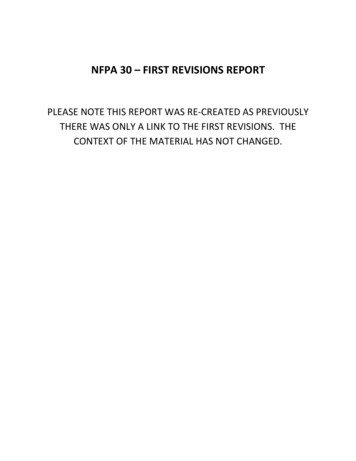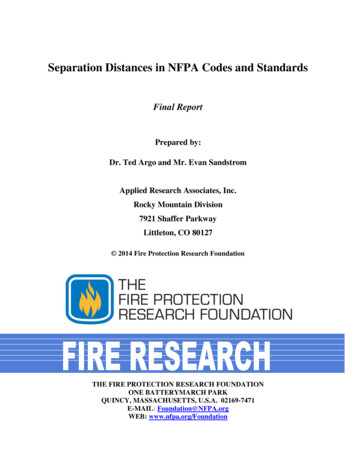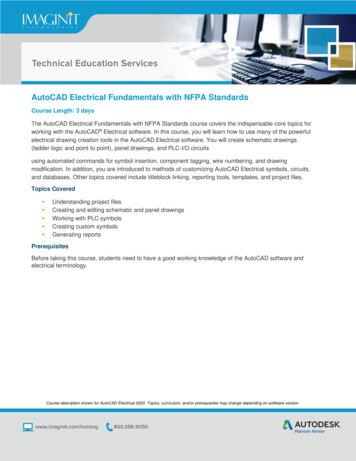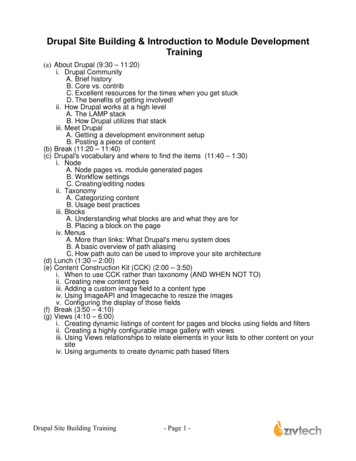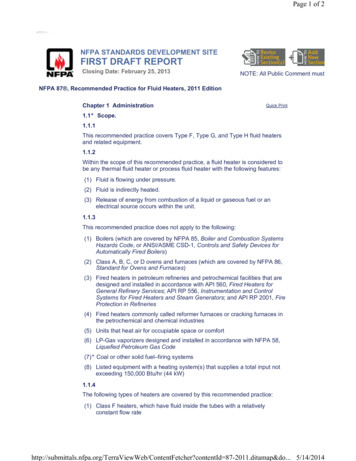
Transcription
Page 1 of 2NFPA STANDARDS DEVELOPMENT SITEFIRST DRAFT REPORTClosing Date: February 25, 2013NOTE: All Public Comment mustWelcome Joanne Goyette!NFPA 87 , Recommended Practice for Fluid Heaters, 2011 EditionChapter 1 AdministrationQuick Print1.1* Scope.1.1.1This recommended practice covers Type F, Type G, and Type H fluid heatersand related equipment.1.1.2Within the scope of this recommended practice, a fluid heater is considered tobe any thermal fluid heater or process fluid heater with the following features:(1) Fluid is flowing under pressure.(2) Fluid is indirectly heated.(3) Release of energy from combustion of a liquid or gaseous fuel or anelectrical source occurs within the unit.1.1.3This recommended practice does not apply to the following:(1) Boilers (which are covered by NFPA 85, Boiler and Combustion SystemsHazards Code, or ANSI/ASME CSD-1, Controls and Safety Devices forAutomatically Fired Boilers)(2) Class A, B, C, or D ovens and furnaces (which are covered by NFPA 86,Standard for Ovens and Furnaces)(3) Fired heaters in petroleum refineries and petrochemical facilities that aredesigned and installed in accordance with API 560, Fired Heaters forGeneral Refinery Services; API RP 556, Instrumentation and ControlSystems for Fired Heaters and Steam Generators; and API RP 2001, FireProtection in Refineries(4) Fired heaters commonly called reformer furnaces or cracking furnaces inthe petrochemical and chemical industries(5) Units that heat air for occupiable space or comfort(6) LP-Gas vaporizers designed and installed in accordance with NFPA 58,Liquefied Petroleum Gas Code(7) * Coal or other solid fuel–firing systems(8) Listed equipment with a heating system(s) that supplies a total input notexceeding 150,000 Btu/hr (44 kW)1.1.4The following types of heaters are covered by this recommended practice:(1) Class F heaters, which have fluid inside the tubes with a relativelyconstant flow tFetcher?contentId 87-2011.ditamap&do. 5/14/2014
Page 2 of tcher?contentId 87-2011.ditamap&do. 5/14/2014
Page 1 of 2NFPA STANDARDS DEVELOPMENT SITEFIRST DRAFT REPORTClosing Date: February 25, 2013NOTE: All Public Comment mustWelcome Joanne Goyette!NFPA 87 , Recommended Practice for Fluid Heaters, 2011 EditionChapter 2 Referenced PublicationsQuick Print2.1 General.The documents or portions thereof listed in this chapter are referenced withinthis recommended practice and should be considered part of therecommendations of this document.2.2 NFPA Publications.National Fire Protection Association, 1 Batterymarch Park, Quincy, MA 021697471.NFPA 10, Standard for Portable Fire Extinguishers, 2010 edition.NFPA 11, Standard for Low-, Medium-, and High-Expansion Foam, 2010edition.NFPA 12, Standard on Carbon Dioxide Extinguishing Systems, 2008 edition.NFPA 13, Standard for the Installation of Sprinkler Systems, 2010 edition.NFPA 15, Standard for Water Spray Fixed Systems for Fire Protection, 2007edition.NFPA 17, Standard for Dry Chemical Extinguishing Systems, 2009 edition.NFPA 17A, Standard for Wet Chemical Extinguishing Systems, 2009 edition.NFPA 25, Standard for the Inspection, Testing, and Maintenance of WaterBased Fire Protection Systems, 2011 edition.NFPA 31, Standard for the Installation of Oil-Burning Equipment, 2006 edition.NFPA 54, National Fuel Gas Code, 2009 edition.NFPA 58, Liquefied Petroleum Gas Code, 2011 edition.NFPA 70 , National Electrical Code , 2011 edition.NFPA 79, Electrical Standard for Industrial Machinery, 2007 edition.NFPA 85, Boiler and Combustion Systems Hazards Code, 2007 edition.NFPA 86, Standard for Ovens and Furnaces, 2011 edition.NFPA 750, Standard on Water Mist Fire Protection Systems, 2010 edition.2.3 Other Publications.2.3.1 API Publications.American Petroleum Institute, 1220 L Street, NW, Washington, DC 200054070.API 560, Fired Heaters for General Refinery Services, 2007.API RP 556, Instrumentation and Control Systems for Fired Heaters and SteamGenerators, 1997.API RP 2001, Fire Protection in Refineries, ntFetcher?contentId 87-2011.ditamap&do. 5/14/2014
Page 2 of 22.3.2 ASME Publications.American Society of Mechanical Engineers, Three Park Avenue, New York, NY10016-5990.ANSI/ASME Boiler and Pressure Vessel Code, 2007.ANSI/ASME B31.1, Power Piping, 2007.ANSI/ASME B31.3, Process Piping, 2008.ANSI/ASME CSD-1, Controls and Safety Devices for Automatically FiredBoilers, 2006.FR-62Hide Legislative2.3.3 ASTM Publications.ASTM International, 100 Barr Harbor Drive, P.O. Box C700, WestConshohocken, PA 19428-2959.ASTM D 396, Standard Specifications for Fuel Oils, 2009.Global FR-62 Hide Deleted2.3.4 IEC Publications.International Electrical Commission, 3 rue de Varembé, P.O. Box 131, CH 1211, Geneva 20, Switzerland.IEC 61511, Functional Safety: Safety Instruments Systems for the ProcessIndustry Sector, 2004.PIs [1]FR-1Hide Legislative2.3.5 UL Publications.Underwriters Laboratories Inc., 333 Pfingsten Road, Northbrook, IL 600622096.UL 795, Standard for Commercial-Industrial Gas HeatingEquipment,2006 2011 .2.3.6 Other Publications.Merriam-Webster’s Collegiate Dictionary, 11th edition, Merriam-Webster, Inc.,Springfield, MA, 2003.2.4 References for Extracts in Recommendation Sections.NFPA 54, National Fuel Gas Code, 2009 edition.NFPA 70 , National Electrical Code , 2011 edition.NFPA 86, Standard for Ovens and Furnaces, 2011 edition.NFPA 211, Standard for Chimneys, Fireplaces, Vents, and Solid Fuel–BurningAppliances, 2010 edition.NFPA 820, Standard for Fire Protection in Wastewater Treatment andCollection Facilities, 2008 ntentFetcher?contentId 87-2011.ditamap&do. 5/14/2014
Page 1 of 6NFPA STANDARDS DEVELOPMENT SITEFIRST DRAFT REPORTClosing Date: February 25, 2013NOTE: All Public Comment mustWelcome Joanne Goyette!NFPA 87 , Recommended Practice for Fluid Heaters, 2011 EditionChapter 3 DefinitionsQuick Print3.1 General.The definitions contained in this chapter apply to the terms used in thisrecommended practice. Where terms are not defined in this chapter or withinanother chapter, they should be defined using their ordinarily acceptedmeanings within the context in which they are used. Merriam-Webster’sCollegiate Dictionary, 11th edition, is the source for the ordinarily acceptedmeaning.3.2 NFPA Official Definitions.3.2.1* Approved.Acceptable to the authority having jurisdiction.3.2.2* Authority Having Jurisdiction (AHJ).An organization, office, or individual responsible for enforcing the requirementsof a code or standard, or for approving equipment, materials, an installation, ora procedure.3.2.3 Labeled.Equipment or materials to which has been attached a label, symbol, or otheridentifying mark of an organization that is acceptable to the authority havingjurisdiction and concerned with product evaluation, that maintains periodicinspection of production of labeled equipment or materials, and by whoselabeling the manufacturer indicates compliance with appropriate standards orperformance in a specified manner.3.2.4* Listed.Equipment, materials, or services included in a list published by an organizationthat is acceptable to the authority having jurisdiction and concerned withevaluation of products or services, that maintains periodic inspection ofproduction of listed equipment or materials or periodic evaluation of services,and whose listing states that either the equipment, material, or service meetsappropriate designated standards or has been tested and found suitable for aspecified purpose.3.2.5 Recommended Practice.A document that is similar in content and structure to a code or standard butthat contains only nonmandatory provisions using the word “should” to indicaterecommendations in the body of the text.3.2.6 Shall.Indicates a mandatory requirement.3.2.7 Should.Indicates a recommendation or that which is advised but not required.3.2.8 ontentFetcher?contentId 87-2011.ditamap&do. 5/14/2014
Page 2 of 6A document, the main text of which contains only mandatory provisions usingthe word “shall” to indicate requirements and which is in a form generallysuitable for mandatory reference by another standard or code or for adoptioninto law. Nonmandatory provisions shall be located in an appendix or annex,footnote, or fine-print note and are not to be considered a part of therequirements of a standard.3.3 General Definitions.3.3.1 Automatic Fire Check.A flame arrester equipped with a check valve to shut off the fuel gas supplyautomatically if a backfire occurs. [86, 2011]3.3.2 Backfire Arrester.A flame arrester installed in fully premixed air–fuel gas distribution piping toterminate flame propagation therein, shut off fuel supply, and relieve pressureresulting from a backfire. [86, 2011]PIs [1]FR-21Hide Legislative3.3.3 Burner.A device or group of devices used for the introduction of fuel and air into a fluidheater at the required velocities, turbulence, and concentration to maintainignition and combustion of fuel.3.3.3.1 Dual-Fuel Burner.A burner designed to burn either fuel gas or liquid fuel but not to burn bothsimultaneously.Global FR-21 Hide Deleted3.3.4 Burner Management System.The field devices, logic system, and final control elements dedicated tocombustion safety and operator assistance in the starting and stopping of fuelpreparation and burning equipment and for preventing misoperation of anddamage to fuel preparation and burning equipment.3.3.5 Combustion Air.The air necessary to provide for the complete combustion of fuel and usuallyconsisting of primary air, secondary air, and excess air. [211, 2010]PIs [1]3.3.6 Combustion Safeguard.A safety control directly responsive to flame properties that senses thepresence or absence of flame and de-energizes the fuel safety shutoff valve inthe event of flame failure.3.3.7 Combustion Safety Circuitry.That portion of the fluid heater control circuitry that contains the contacts,arranged in series ahead of the safety shutoff valve(s) holding medium, for therecommended safety interlocks and the excess temperature limit controller(s).3.3.8 Controller.3.3.8.1 Programmable /ContentFetcher?contentId 87-2011.ditamap&do. 5/14/2014
Page 3 of 6A digital electronic system designed for use in an industrial environment thatuses a programmable memory for the internal storage of user-orientedinstructions for implementing specific functions to control, through digital oranalog inputs and outputs, various types of machines or processes. [86, 2011]PIs [1]3.3.8.2 Temperature Controller.A device that measures the temperature and automatically controls the input ofheat into the fluid heater.FR-2Hide Legislative3.3.9 Emergency Shutoff Valve.A manual shutoff valve to allow the fuel to be turned off in an emergency.FR-2Hide Legislative3.3.10 Equipment Isolation Valve.A manual shutoff valve for shutoff of the fuel to each piece of equipment.PIs [2]FR-22Hide Legislative3.3.11 Explosive Range. Flammable Limit.The range of concentration of a flammable gas in air within which a flame canbe propagated, with the lowest flammable concentration known as the lowerexplosive limit (LEL) flammable limit (LFL) , and the highest flammableconcentration known as the upper explosive limit (UEL) flammable limit (UFL) .3.3.12 Fluid Heater.3.3.12.1 Class F Fluid Heater.A heater that has fluid inside the tubes with essentially constant fluid flow rateand where the outlet temperature of the fluid is controlled by modulating theheat input rate to the heater.3.3.12.2 Class G Fluid Heater.A heater that has fluid inside the tubes with modulated fluid flow rate (e.g., byprocess demand) and where the outlet temperature of the fluid is controlled bymodulating the heat input rate to the heater.3.3.12.3 Class H Fluid Heater.A heater that has the heat source (combustion or electricity) inside the tube(s)with fluid surrounding the tube.3.3.13 Fuel Gas.A gas used as a fuel source, including natural gas, manufactured gas, sludgegas, liquefied petroleum gas–air mixtures, liquefied petroleum gas in the vaporphase, and mixtures of these gases. [820, 2008]3.3.14 Fuel Oil.Grades 2, 4, 5, or 6 fuel oils as defined in ASTM D 396, Standard Specificationsfor Fuel Oils.3.3.15 Gas Analyzer.A device that measures concentrations, directly or indirectly, of some or allcomponents in a gas or mixture. [86, ntFetcher?contentId 87-2011.ditamap&do. 5/14/2014
Page 4 of 6FR-44PIs [1]Hide Legislative3.3.16 Guarded.Covered, shielded, fenced, enclosed, or otherwise protected by means ofsuitable covers, casings, barriers, rails, screens, mats, or platforms to removethe likelihood of approach or contact by persons or objects to a point of danger.[70: Article 100]Global FR-44 Hide Deleted3.3.17*Hardwired.The method of interconnecting signals or interlocks to a logic system orbetween logic systems using a dedicated interconnection for each individualsignal.3.3.18 Interlock.3.3.18.1 Excess Temperature Limit Interlock.A device designed to cut off the source of heat if the operating temperatureexceeds a predetermined temperature set point.3.3.18.2 Safety Interlock.A device required to ensure safe start-up and safe operation and to cause safeequipment shutdown.PIs [1]FR-23Hide Legislative3.3.19 Lower Explosive Limit (LEL). Flammable Limit (LFL).See 3.3.8 3.3.11 , Explosive Range Flammable Limits .FR-37Hide Legislative3.3.20 Manufacturer.The entity that directs and controls any of the following: product design,product manufacturing, or product quality assurance; or the entity thatassumes the liability for the product or provides the warranty for the product.3.3.21 Mixer.3.3.21.1 Air–Fuel Gas Mixer.A mixer that combines air and fuel gas in the proper proportions for combustion.[86, 2011]3.3.21.2 Prop
NFPA 750, Standard on Water Mist Fire Protection Systems, 2010 edition. 2.3 Other Publications. 2.3.1 API Publications. American Petroleum Institute, 1220 L Street, NW, Washington, DC 20005-4070. API 560, Fired Heaters for General Refinery Services, 2007. API RP 556, Instrumentation and Control Systems for Fired Heaters and Steam Generators, 1997.
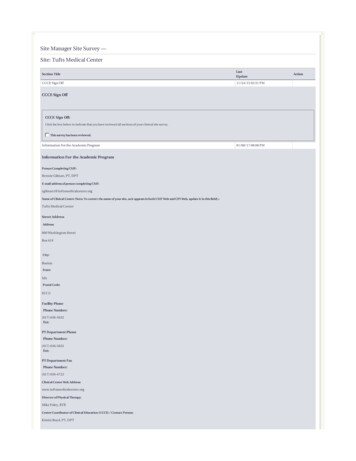
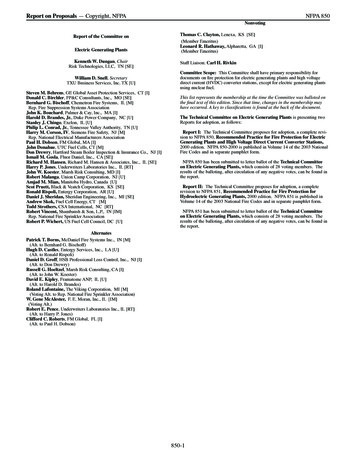
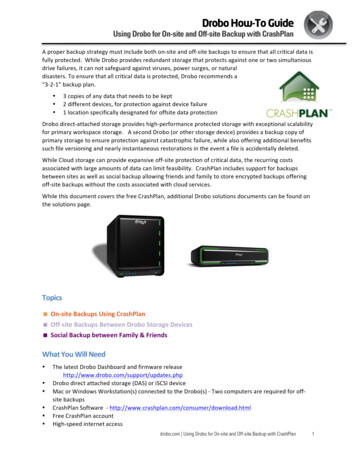
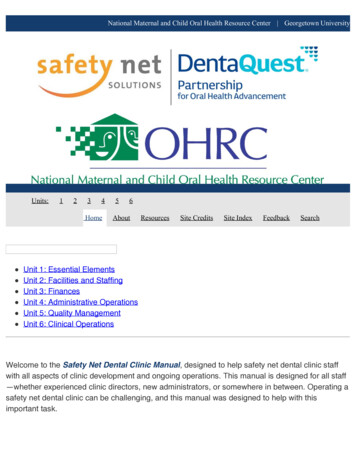
![First Revision No. 147-NFPA 20-2013 [ Global Input ]](/img/4/20-a15-fim-aaa-fd-frstatements.jpg)
![First Revision No. 2-NFPA 33-2016 [ Section No. 1.3 ]](/img/4/33-f2017-faa-aaa-frreport.jpg)
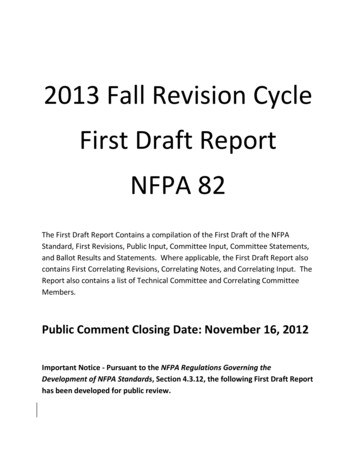
![First Revision No. 3-NFPA 497-2014 [ Chapter 2 ]](/img/5/497-a2016-eec-aaa-fd-frstatments.jpg)
